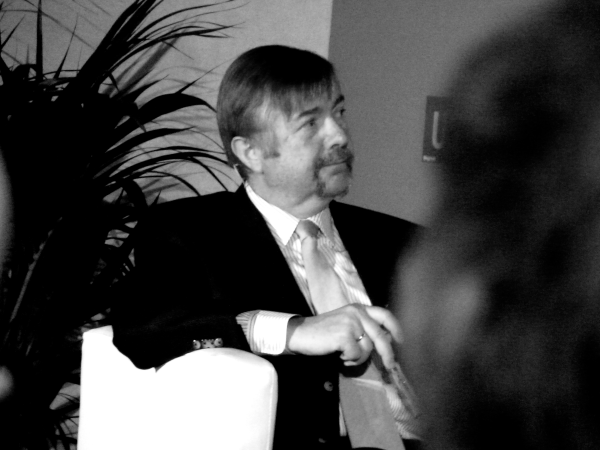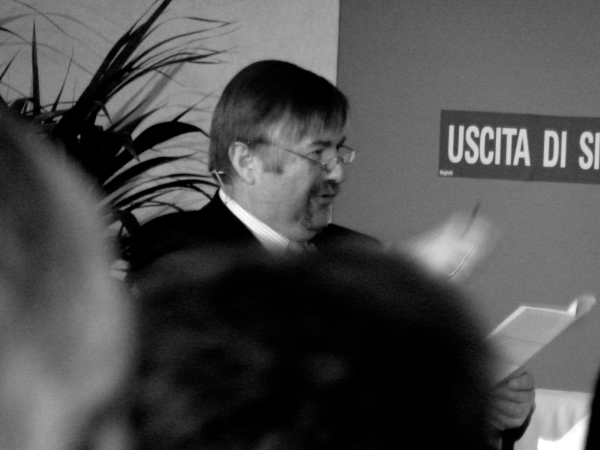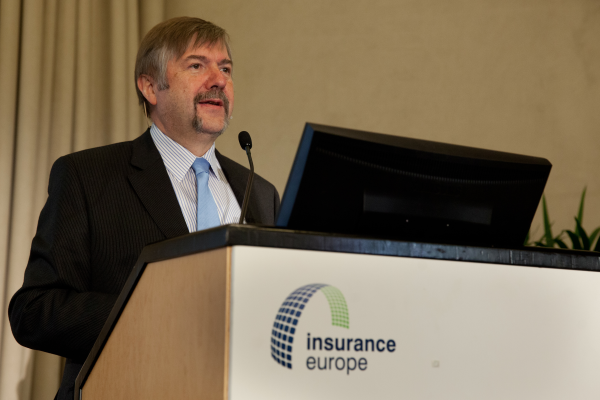
In Part 1 Professor Karel Van Hulle, the retired Head of the Insurance and Pensions Unit at the European Commission, reflects on Solvency II, its achievements and the industry’s attitude.
In Part 2 he continues his conversation with Gideon Benari, Editor of Solvency II Wire, discussing lobbying, the need for an objective testing ground for new rules and a novel approach to supervision.
—
The music changes again. We are now subjected to a trumpet tooting version of Copacabana. A table and a pillar away a group of holidaymakers engage in boisterous and very (very) loud conversation. They are so loud that when I transcribed the interview back at my desk in London I realised I could probably reconstruct their entire conversation. The noon sun still blazes down around us, baking everything that is not covered. Occasionally you can hear the splash of someone diving into the pool. It is time to order more coffee.

Talk about industry preparation and resistance to reporting leads our conversation to the prickly topic of lobbying and dialogue between regulators and firms.
“What I have learned in my career as a regulator is that whenever somebody tells me: ‘this is not possible’, then they are really ducking the issue. And my standing reaction to that is: if it is not possible, we will make it possible. You can’t find a method? We will provide you with the method,” he says categorically.
“It’s not a credible argument. If people say that this is technically impossible, then I would say: well use another consultant.” You can almost feel the weight of experience in his words. They are not delivered in anger, but with the sort of incredulity that a parent might approach their teenage son who has come up with the umpteenth excuse why it is ‘im … poss … i … ble’ to take out the bin and go to the movies on the same night.
When designing regulation for complex industries such as finance, rule makers must contend with an ever-present paradox: a dependence on the industry’s technical knowledge to help design effective rules. How do you sift between what is lobbying and industry trying to bend the rules in their interest and what is genuinely a technical concern?
“Well, [sigh. deep breath] that is something that will always remain difficult.” He pauses. “It would be fantastic if regulators would be faced with a stakeholder group that would always be a hundred per cent clear about what the real problems are. But that’s not the way the world operates today. So you have the industry coming up with five issues of which de facto only one is important. That’s negotiation. And that’s why it is so important, I find it, that people involved in regulation know what is really going on. It is on that issue that I spent a lot of my time. Also during my free time, when I was in the Commission, I talked to a lot of people to learn what the real issues are so that when I got a submission I could see what elements in that submission were serious.”

Do you think the regulator sometimes proposes more stringent rules knowing that they are going to be watered down?
His reaction is almost identical to that of the previous question … “I would not exclude that that is the case. If you make a proposal you have to be realistic that your proposal will rarely be adopted as it is, so you may want the proposal to be a little bit over demanding.”
He then steers the conversation towards what he believes could help reconcile the paradox. “For regulators there rarely is an objective testing ground. And that’s where I would like to work on a little bit in the future. To find ways and means whereby academia can play their role.”
After leaving the Commission this February Professor Van Hulle returned to the academic realm and took up lecturing positions at the Business and Economics Faculty of the Catholic University Leuven, Belgium, his home country, and the International Centre for Insurance Regulation at the Goethe University in Frankfurt, where he is also an executive member of the board.
Creating an “objective testing ground” is very much on his mind. “I think this is something which is missing almost in all areas of regulation. And particularly in insurance, we don’t have an academic breeding ground of ideas, of solutions and of options that regulators – when they have to take the final decision – can actually go back to and say, that makes sense because we have an objective partner who came to that conclusion too.”
In no area of Solvency II has this been more needed than in the long-term guarantees debate. The whole approach could benefit from a bit more pragmatism and a little less obsession with numbers, he believes. “All these people who are now shooting at these solutions for long-term guarantees, these adjustments, and say this is not market consistent. My question is what is market-consistent? Where does it say in stone, in the Bible, that there is only one way to deal with this issue?”
“These people” are those actuaries and academics that have been critical of the way Solvency II Long-Term Guarantees measures will manipulate (they would say ‘fudge’) market-consistent valuation to cushion the balance sheets of insurance firms from short-term market volatility.

By any account this is not a simple debate. The accepted method that relies on discounting liabilities at a risk-free rate does not work in the current economic environment because the entire concept of a risk-free asset has been rattled to its foundation by the Eurozone crisis. “What’s a risk-free discount rate today?” he asks. “In the past, actuaries argued that the appropriate discount rate had to be the risk-free rate. What is risk-free today, tell me what it is,” he again erupts into a gentle salvo of rhetorical questions.
“The answer in the past was very obvious – it was the government bond rate. But things have changed. So we have to find other ways. And I think it’s time in insurance that people start to look beyond their plate and move away from the old theory and take account of what is happening in the real world.”
As he says this he points to his plate, or rather the empty espresso cup and saucer in front of him, and begins a short sequence of finger pointing and object shifting on our table to explain his idea. “It’s not all about mathematical modelling of things, it’s also about judgment, using judgment. Putting your plate on the table and not having a plate just in front of you and restricting yourself to options on that plate. Your plate is on a table with food. You may have to use a different plate when you have different types of food.”
The sequence reminds me of one of my favourite short films, ‘Coffee and Cigarettes’ (1986), by Jim Jarmush. In this black and white gem Roberto Benigni conducts a frenetic conversation with comedian Steven Right at a small coffee table cluttered with espresso cups and two ashtrays. If only Karel had done his actions to the beat of the music blasting from the speakers it would have made a lovely little movie scene.

But the little dance of the plates serves its purpose, reinforcing the need to look outside of the normal framework to deal with a situation that has fundamentally reshaped our view of the world.
“The real question in insurance, maybe more than in other areas, is that there is a tendency to look at it purely from a quantitative perspective, whilst the qualitative aspects are very important. The business reality must be considered. These things serve a purpose. We are not valuing these liabilities for the sake of enjoying it. We are doing it because these liabilities serve a purpose. And we are talking about long-term liabilities. So by the time your liability will have come to its maturity, it is not unlikely that there will have been other adjustments in the market.”
Our conversation is drawing to a close. Most of the holidaymakers are either back by the pool or disappeared, perhaps to take a siesta in a cooler place. The music, like the sun, is relentless.
In his closing thoughts he talks about the supervisory process and stresses that it is important to understand that supervision as it is designed under Solvency II is based on dialogue, which is different from Solvency I. “This is important because it means that if you want to have good supervision you need to have partners at an equal level.”
“There is no doubt that an insurer will know his insurance company better then a supervisor will ever know it. But Solvency II requires the supervisor to get a bit more familiar with the insurance undertaking. If the supervisor needs to know what the insurer is doing, then he needs to talk to the insurer. He needs to understand the business and the insurer must provide him with the data that allow him to have the better understanding. And that is why all these pillars fit nicely together. I have always attached very much importance to this dialogue, this regular dialogue between the insurance undertaking and the supervisor, which requires a mental change on both sides.”
Making that “mental change” could benefit both parties.
“The supervisor is not an adversary, he is my partner in making sure that I can deliver on my promises. And maybe it would be good for me as an insurer to go and see my supervisor and when he says that I should attach more importance to a particular issue, I should be happy that somebody tells me. Because the objectives are basically the same.”
As our conversation tapers off he reflects on the growing trend of more intrusive supervision in the post crisis environment. In hindsight it seems to be a reflection on his career and attitude to Solvency II.
”As a regulator you learn that things may take a long time, you also learn to be modest. You rarely know all the consequences when you start preparing new regulation. You might think, ‘I’ve got a perfect rule’. I have learned not to say anymore that a rule is perfect. I have never written that Solvency II is perfect. It was not meant to be perfect. It’s an evolving thing. But the basic philosophy is good. And unless I find something else that is better, I will defend it.”









Okay so I understand better now how the long term guarantee issue has thrown a spanner in the whole Solvency 2 project, but was a little surprised that Karel Van Hulle was not prepared to have a more wide ranging discussion. His justification for his view that something other than government bond rates should be used as the risk free rate of return was bizarre: “Your plate is on a table with food. You may have to use a different plate when you have different types of food.”
And no discussion at all about the seemingly arbitrary extension of Pillars 2 and 3 (even if not Pillar 1 for now) to occupational pension schemes as if they were insurance undertakings. The suspicion that the discussions within the European Commission on appropriate levels of regulation have had too narrow a focus for some time now are confirmed.